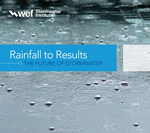 A new Water Environment Federation report, “Rainfall to Results: The Future of Stormwater,” details challenges, opportunities and pathways to improving the nation’s drainage infrastructure and yielding a more resilient and effective stormwater sector. Its release during the WEFTEC 2015 conference in Chicago dovetailed the launch of the WEF Stormwater Institute, billed as a new center of excellence and innovation.
A new Water Environment Federation report, “Rainfall to Results: The Future of Stormwater,” details challenges, opportunities and pathways to improving the nation’s drainage infrastructure and yielding a more resilient and effective stormwater sector. Its release during the WEFTEC 2015 conference in Chicago dovetailed the launch of the WEF Stormwater Institute, billed as a new center of excellence and innovation.
Drawing from the insights of top U.S. stormwater experts, the report finds a) the growing issue of stormwater pollution, coupled with regulatory pressure, is driving the need for innovative approaches, training, technology solutions, and progressive financing; and, b) there is a clear need for national leadership and collaboration to help forge the path to more sustainable stormwater management.
“‘Rainfall to Results’ details a clear vision for where we need to be on stormwater issues, but more importantly, it also gives us a map for getting there,” says WEF President Ed McCormick. “From encouraging work at the watershed level to improving governance and the regulatory environment, the report gives practitioners the tools they need to sustainably manage stormwater.”
According to the report, collaborative action across all disciplines within the stormwater sector and broader community engagement will be required to achieve the envisioned future in which all stormwater will be managed through an optimized mix of affordable and sustainable green, gray, and natural infrastructure. Authors peg six critical objectives toward that goal:
- Watershed-scale work. Communities will have integrated, watershed-scale assessments of water needs and challenges;
- Stormwater governance transformation. Communities will catalyze further formation of utilities and regulations to stimulate stormwater control innovation and performance improvement by focusing on program outcomes;
- Innovation and best practices. A broad suite of verified stormwater controls and best practices will support confident planning and maintenance;
- Asset and resource management. Stormwater systems will be maintained through asset management programs and supported by innovative information technology;
- Funding gap closure. Communities will align stormwater management efforts with broader community goals to garner funding options and have access to innovative financing opportunities; and,
- Community engagement. Communities will understand and value the contribution stormwater management makes to flood risk reduction, clean and safe water, climate resiliency, and other benefits.
“Improving stormwater management will be a key aspect of building resilience in the face of uncertain climate patterns and extreme weather events,” says CDM Senior Planner and WEF Stormwater Committee Chair Mike Beezhold. “We need to integrate stormwater into broader regional and community planning and ensure we are managing stormwater in a sustainable way.” — Water Environment Federation, Alexandria, Va.; www.wefstormwaterinstitute.org
